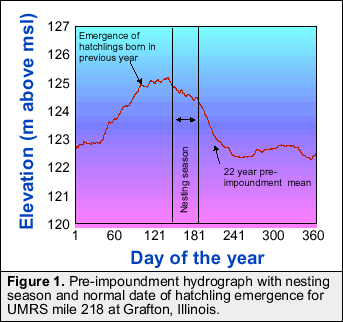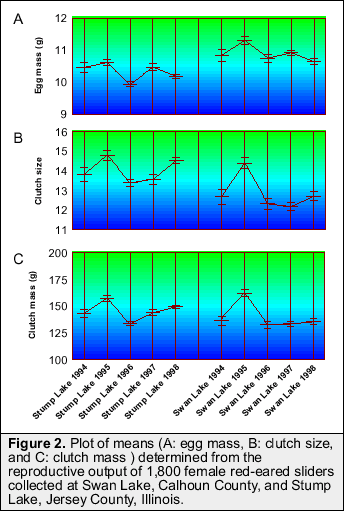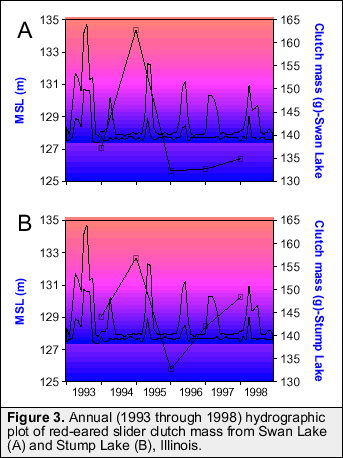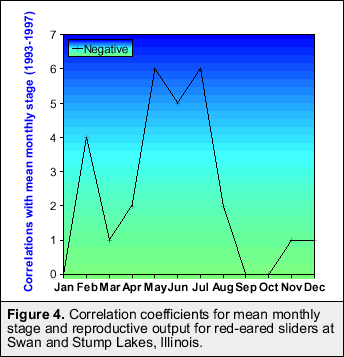|
 Project Status Reports
Project Status Reports
|
|
PSR 99-06 July 1999
Natural History of the Red-Eared Slider Relative to a Variable
Hydrologic Regime
by John K. Tucker
|
|
The impacts of hydrologic regimes in large river systems on fish,
birds, trees, and invertebrates have been the focus of many studies.
As a result, we know for instance, that fish reproduction and recruitment
benefit from the natural hydrologic pattern of high spring stages
and lower summer stages. However, despite numerous studies, essentially
nothing is known about the interactions found between hydrologic
patterns and reptiles and amphibians.
|
|
Studies of the natural history of the red-eared slider (Trachemys
scripta elegans) began in 1992 in Pool
26 of the Upper Mississippi River System (UMRS), including the
lower Illinois River, as part of the Long
Term Resource Monitoring Program (LTRMP). These studies are
revealing important information to promote survival of reptiles
and amphibians in the floodplains of the UMRS and other regulated
rivers.
|
|
The red-eared slider (slider), a member of the Emydidae or pond
turtle family, is widely distributed in the Central United States
and occurs in the UMRS south of Pool
13. Turtles in this group commonly bask on logs to thermoregulate.
 When
young, most individuals feed on aquatic invertebrates, but adults,
and particularly sexually mature females, become more herbivorous
with age. Thus, these turtles use two resources whose abundance
is directly related to the health of the UMRS. When
young, most individuals feed on aquatic invertebrates, but adults,
and particularly sexually mature females, become more herbivorous
with age. Thus, these turtles use two resources whose abundance
is directly related to the health of the UMRS.
The sliders reproductive cycle begins in the fall when female ovarian
follicles enlarge. Nesting occurs in late May through June and coincides
with the falling flood pulse of the UMRS prior to lock and dam construction
(Figure 1). The eggs incubate in a shallow nest (about 13 cm deep)
and hatch in 60 to 90 days. Unlike most turtles, hatchling sliders
do not leave the nest after hatching. Instead, they remain in the
shallow nest cavity throughout the fall and winter. Emergence coincides
with the rising flood pulse in early May or late April (Figure 1).
The timing of nesting and emergence are made more critical because
eggs and hatchlings will drown if the nest cavity is submerged prior
to hatchling emergence.
|
|
I am continuing to examine the influence of flooding and other
abiotic variables on reproduction in sliders from two backwater
lakes of the Illinois River, Swan Lake and Stump Lake.  Each
year since 1994, female turtles have been captured on their nesting
migrations that can be as far as 1 km from their aquatic habitats.
They are induced to lay their eggs in the laboratory where the eggs
are counted and weighed. The females are released at the original
collecting areas after oviposition but their hatchlings are overwintered
in captivity. The hatchlings are released after naturally emerging
hatchlings are found. Using these methods, reproductive success
at both sites is being determined. Reproductive output varies from
year to year and from location to location (Figure 2). Generally,
turtles from Swan Lake lay relatively fewer but bigger eggs than
do turtles from Stump Lake. Each
year since 1994, female turtles have been captured on their nesting
migrations that can be as far as 1 km from their aquatic habitats.
They are induced to lay their eggs in the laboratory where the eggs
are counted and weighed. The females are released at the original
collecting areas after oviposition but their hatchlings are overwintered
in captivity. The hatchlings are released after naturally emerging
hatchlings are found. Using these methods, reproductive success
at both sites is being determined. Reproductive output varies from
year to year and from location to location (Figure 2). Generally,
turtles from Swan Lake lay relatively fewer but bigger eggs than
do turtles from Stump Lake.
Sliders become sexually mature after six years and store the energy
needed for the next year’s reproduction in the year before
eggs are laid, i.e., reproduction in 1994 was most influenced by
conditions in 1993. Presently, five years of reproductive output
data have been gathered. Once sufficient data have been collected,
the reproductive output of the turtles will be examined to determine
which abiotic variables best predict variation in yearly reproductive
output. Abiotic variables could include climatic data (e.g., mean
monthly temperatures and rainfall), water regulation data (e.g.,
mean monthly stages at various river gauges), and data on human
activities (e.g., planting and harvesting times).
|
|
 Although preliminary, the relationship to flooding appears to be
an important one. Sliders produced fewer and smaller eggs in the
year following flood events (e.g., 1993, 1995, 1996) when minimum
monthly stages exceed targeted regulated levels but produce larger
and more eggs following years such as 1994 and 1997 when flooding
was slight (Figure 3). The effect occurs at both study sites and
can change reproductive output by as much at 20%. The causal factors
for the effect on turtle reproductive output is uncertain but may
be related to reduced availability of submersed aquatic vegetation
during larger floods. Mean monthly stage and the three measures
of reproductive output (egg mass, clutch size, and clutch mass)
for both sites (a total of six correlations) tend to be negatively
related during the active season of the turtles (Figure 4). All
six correlations were negative with mean stage in May and July and
five of the correlations were negative with mean stage for June
suggesting that reproductive output decreases with increasing stage.
This is a preliminary result but one that may be strengthened when
sufficient data are accumulated to allow a multivariate study.
Although preliminary, the relationship to flooding appears to be
an important one. Sliders produced fewer and smaller eggs in the
year following flood events (e.g., 1993, 1995, 1996) when minimum
monthly stages exceed targeted regulated levels but produce larger
and more eggs following years such as 1994 and 1997 when flooding
was slight (Figure 3). The effect occurs at both study sites and
can change reproductive output by as much at 20%. The causal factors
for the effect on turtle reproductive output is uncertain but may
be related to reduced availability of submersed aquatic vegetation
during larger floods. Mean monthly stage and the three measures
of reproductive output (egg mass, clutch size, and clutch mass)
for both sites (a total of six correlations) tend to be negatively
related during the active season of the turtles (Figure 4). All
six correlations were negative with mean stage in May and July and
five of the correlations were negative with mean stage for June
suggesting that reproductive output decreases with increasing stage.
This is a preliminary result but one that may be strengthened when
sufficient data are accumulated to allow a multivariate study.

Regardless, the variation in reproductive output in turtles found
by these studies is unique. The findings strongly support various
optimal egg theories and previous poorly supported ideas about the
importance of local conditions in turtle reproduction.
Even though turtle reproductive output may decrease in the year
following a flood year, the net effect on turtle recruitment may
be positive. Other studies that are in progress suggest that hatchling
survivorship is related to the distance that hatchlings must travel
to reach an aquatic habitat after emerging from the nests. During
flood years, this distance is greatly reduced and survivorship may
be increased. Even though reproductive output may decrease, recruitment
may increase enough to counter the lower output.
Many of the relationships between the river and the natural history
of the slider, noted above, have only recently been developed through
studies carried out at Pool 26 by LTRMP
field station scientists. These studies demonstrate the complex
adaptations that allow turtles to maximize fitness in these variable
environments.
|
| |
|
This report is a product of the Long Term
Resource Monitoring Program for the Upper Mississippi River
System.
For further information, contact
John K. Tucker
Illinois Natural History Survey
LTRMP Field Station
8450 Montclaire Ave.
Brighton, Illinois 62012, USA
Phone: 618/466-9690
Fax: 618/466-9688
E-mail:jktucker@inhs.uiuc.edu
U.S. Geological Survey
Upper Midwest Environmental Sciences Center
2630 Fanta Reed Road
La Crosse, Wisconsin 54603
Phone: 608/783-7550
Fax: 608/783-8058
Project Status Reports (PSRs) are preliminary documents whose purpose
is to provide information on scientific activities. Because PSRs
are only subject to internal peer review, they may not be cited.
Use of trade names does not imply U.S. Government endorsement of
commercial products.
All Project Status Reports are accessible through the Upper Midwest
Environmental Sciences Center’s website at http://umesc.usgs.gov/reports_publications/psrs/umesc_psr.html
|


 When
young, most individuals feed on aquatic invertebrates, but adults,
and particularly sexually mature females, become more herbivorous
with age. Thus, these turtles use two resources whose abundance
is directly related to the health of the UMRS.
When
young, most individuals feed on aquatic invertebrates, but adults,
and particularly sexually mature females, become more herbivorous
with age. Thus, these turtles use two resources whose abundance
is directly related to the health of the UMRS. Each
year since 1994, female turtles have been captured on their nesting
migrations that can be as far as 1 km from their aquatic habitats.
They are induced to lay their eggs in the laboratory where the eggs
are counted and weighed. The females are released at the original
collecting areas after oviposition but their hatchlings are overwintered
in captivity. The hatchlings are released after naturally emerging
hatchlings are found. Using these methods, reproductive success
at both sites is being determined. Reproductive output varies from
year to year and from location to location (Figure 2). Generally,
turtles from Swan Lake lay relatively fewer but bigger eggs than
do turtles from Stump Lake.
Each
year since 1994, female turtles have been captured on their nesting
migrations that can be as far as 1 km from their aquatic habitats.
They are induced to lay their eggs in the laboratory where the eggs
are counted and weighed. The females are released at the original
collecting areas after oviposition but their hatchlings are overwintered
in captivity. The hatchlings are released after naturally emerging
hatchlings are found. Using these methods, reproductive success
at both sites is being determined. Reproductive output varies from
year to year and from location to location (Figure 2). Generally,
turtles from Swan Lake lay relatively fewer but bigger eggs than
do turtles from Stump Lake. Although preliminary, the relationship to flooding appears to be
an important one. Sliders produced fewer and smaller eggs in the
year following flood events (e.g., 1993, 1995, 1996) when minimum
monthly stages exceed targeted regulated levels but produce larger
and more eggs following years such as 1994 and 1997 when flooding
was slight (Figure 3). The effect occurs at both study sites and
can change reproductive output by as much at 20%. The causal factors
for the effect on turtle reproductive output is uncertain but may
be related to reduced availability of submersed aquatic vegetation
during larger floods. Mean monthly stage and the three measures
of reproductive output (egg mass, clutch size, and clutch mass)
for both sites (a total of six correlations) tend to be negatively
related during the active season of the turtles (Figure 4). All
six correlations were negative with mean stage in May and July and
five of the correlations were negative with mean stage for June
suggesting that reproductive output decreases with increasing stage.
This is a preliminary result but one that may be strengthened when
sufficient data are accumulated to allow a multivariate study.
Although preliminary, the relationship to flooding appears to be
an important one. Sliders produced fewer and smaller eggs in the
year following flood events (e.g., 1993, 1995, 1996) when minimum
monthly stages exceed targeted regulated levels but produce larger
and more eggs following years such as 1994 and 1997 when flooding
was slight (Figure 3). The effect occurs at both study sites and
can change reproductive output by as much at 20%. The causal factors
for the effect on turtle reproductive output is uncertain but may
be related to reduced availability of submersed aquatic vegetation
during larger floods. Mean monthly stage and the three measures
of reproductive output (egg mass, clutch size, and clutch mass)
for both sites (a total of six correlations) tend to be negatively
related during the active season of the turtles (Figure 4). All
six correlations were negative with mean stage in May and July and
five of the correlations were negative with mean stage for June
suggesting that reproductive output decreases with increasing stage.
This is a preliminary result but one that may be strengthened when
sufficient data are accumulated to allow a multivariate study.